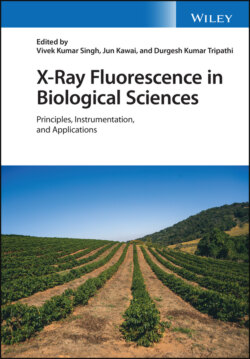Читать книгу X-Ray Fluorescence in Biological Sciences - Группа авторов - Страница 70
5.4 Application of μ‐XRF and XAS in Understanding the Transformation of Elements Driven by Micro‐organisms
ОглавлениеIn the heavy metal enriched environment, the chemical speciation of heavy metal elements is one of the important factors affecting the growth of micro‐organisms. Toxic heavy metal ions can easily replace essential metal ions that are necessary in many enzymes [4, 5]. Micro‐organisms can detoxify through biological processes and survive by changing the chemical speciation, bioavailability, and toxicity of heavy metals.
Redox of toxic elements by micro‐organisms is an important detoxification mechanism. Au (I/III)‐complexes are highly toxic to organisms, while Au nanoparticles (AuNPs) are relatively non‐toxic [16, 17]. Once Au (I/III)‐complexes enter the cells, they easily bind with glutathione and react with oxygen molecules to form oxidized glutathione and hydrogen peroxide, causing high oxidative stress and inhibiting catalase activity [18, 19]. Some micro‐organisms can detoxify through reductive precipitation of Au (III)‐complexes to less toxic Au (0) nanoparticles. Different micro‐organisms have different reduction and detoxification mechanisms for Au (I/III)‐complexes. Micro‐organisms can reduce Au (I/III) to Au (0) through extracellular secretions, reduced proteins on cell membranes, or intracellular reductase (Figure 5.1) [20]. Delftia acidovorans can survive in a solution containing 100 μmol/l AuCl3, but was significantly inhibited when they could not secrete secondary metabolites, suggesting that secondary metabolites can help them to reduce Au (III) to Au(0) [21]. The membrane vesicles produced by many gram‐negative bacteria can be used as a protective shield against the toxic environment [22]. When cyanobacteria were exposed to an Au (III) solution, the cyanobacteria would release the membrane vesicles to wrap the cells and prevent the entrance of Au (III) into the cells, while the reduction of Au (III) to metallic Au involves the formation of Au (I)‐sulfide, as confirmed by XANES [23]. Analysis of XANES and μ‐XRF revealed that Cupriavidus metallidurans accumulated Au(III)‐complexes from the solution, and the cellular Au was coupled to the formation of Au(I)‐S species intermediates, finally leading to the formation of Au(0) in both intra‐ and extracellular reductive precipitation, accompanied by a efflux outside the cell [19].
Figure 5.1 Reduction and detoxification mechanism of gold ions by Rhizopous oryzae cells.
Source: Reproduced from Das et al. [20] with the permission from American Chemical Society.
